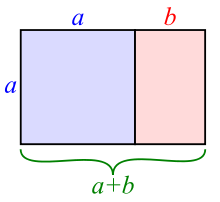This article is about the number.
Line segments in the golden ratio
A golden rectangle with longer side a and shorter side b, when placed adjacent to a square with sides of length a, will produce a similar golden rectangle with longer side a + b and shorter side a. This illustrates the relationship  .
.
 .
. or
or  ) represents the golden ratio. Its value is:
) represents the golden ratio. Its value is:The golden ratio also is called the golden mean or golden section (Latin: sectio aurea).[1][2][3] Other names include extreme and mean ratio,[4] medial section, divine proportion, divine section (Latin: sectio divina), golden proportion, golden cut,[5] and golden number.[6][7][8]
Some twentieth-century artists and architects, including Le Corbusier and Dalí, have proportioned their works to approximate the golden ratio—especially in the form of the golden rectangle, in which the ratio of the longer side to the shorter is the golden ratio—believing this proportion to be aesthetically pleasing.
Mathematicians since Euclid have studied the properties of the golden ratio, including its appearance in the dimensions of a regular pentagon and in a golden rectangle, which may be cut into a square and a smaller rectangle with the same aspect ratio. The golden ratio has also been used to analyze the proportions of natural objects
So after all that its just a way to find pleasing shapes with a number....some would say a magical number. And that leads us to another discipline of spiritual journeys, in 2 dimension reduced to a sacred pathway or sometimes a spiral. In the upper right are sketches of possible magical pathways or mazes reduced to a pattern in clay or metal.
That brings me to the square top right which is like the path around and up to the top of a pyramid, the path of the soul in Egyptian philosophy. And so enters the third discipline. Archeology and history. Look to all these to find inspiration for art jewelry.
And right center is the beginnings of a real piece conceived in doodles on the back of a discarded printout of a map.
I often hear voices online crying "I just don't know where to get an idea, where to start" Look away from what others are doing, pickup a magazine or look online at something you have never looked at before. Put jewelry, design and art in the intent part of your brain and look. Learn to see patterns and forms in new places. Inspiration will come. Be of an open mind so you can recognize it when you perceive it.
Most of all be creative and have fun with beautiful ideas and materials.




